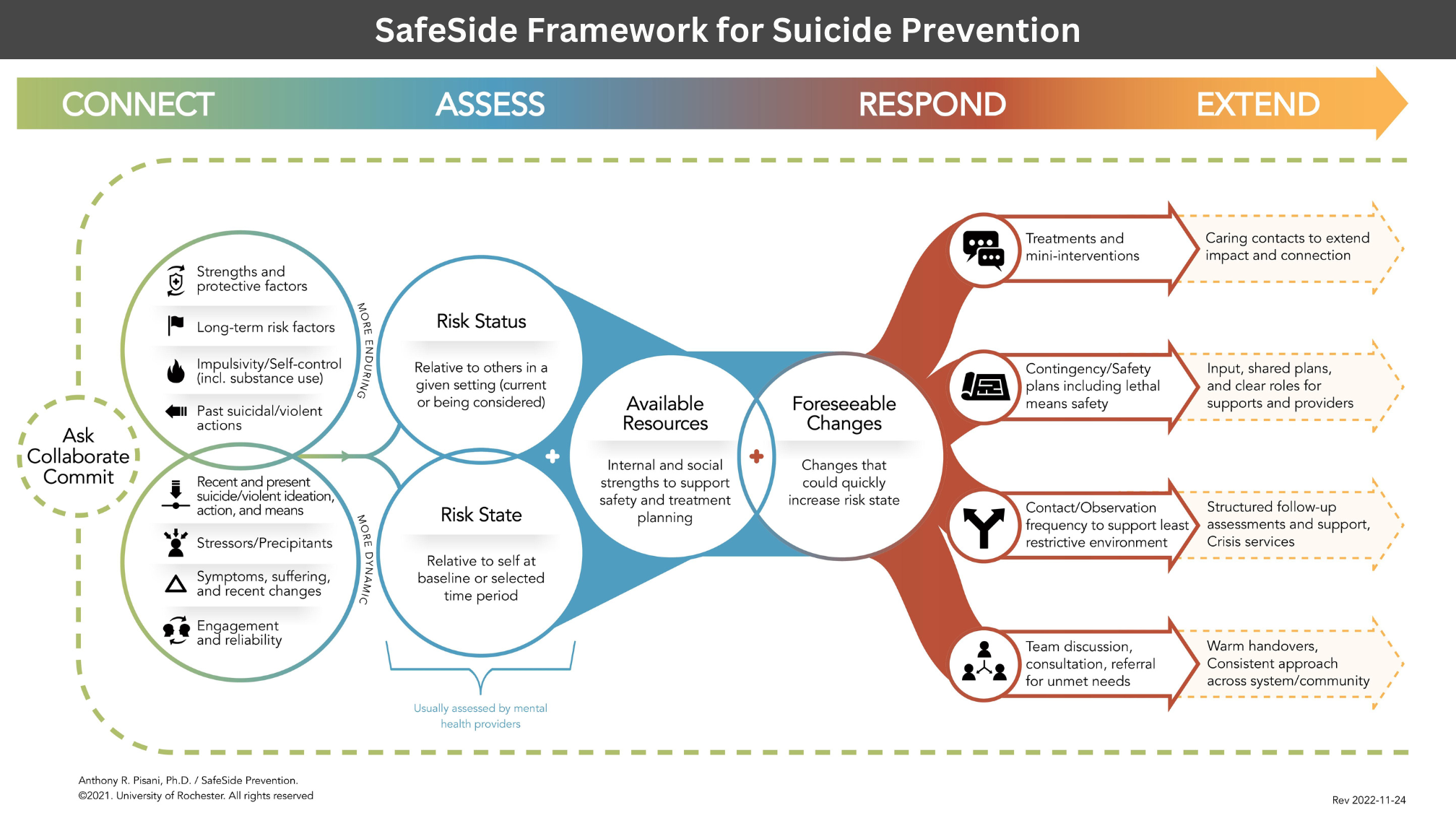Framework for Suicide Prevention: Overview and Evidence Summary
Every problem becomes more manageable when you have a framework.
A Unifying Framework to Guide Suicide Prevention Best Practice Across Roles
The SafeSide Framework is a map of evidence-based and best practices in suicide prevention. The framework is versatile and strategic, having potential for impact at many levels of an organization.
- Individual staff members use the framework to guide, conceptualize, and provide consumers the best the field has to offer.
- Supervisors and teams use the framework as a structure for efficient reviews, co-reflection, and problem-solving.
- Systems and quality improvement leaders use the framework to evaluate and plan improvements to policy, services, and pathways.
- Learning and staff development leaders use the framework and associated resources to identify and address focus areas for suicide prevention education.

The SafeSide Framework is comprised of four core tasks: Connect, Assess, Respond, Extend.
Connect, the foundation of the framework (Klein et al., 2023), includes: how to ask a person directly about suicide while also working to understand the person’s individual context and experience (Berman & Silverman, 2017; Dazzi et al., 2014; O’Reilly et al., 2016), how to collaborate with the person around a common goal, and how to commit to helping the person feel better (Tyndall & Jobes, 2022; Whitlock et al., 2014).
Assess uses a structured approach to gather, organize, and share information to better understand the person. This information is then used to articulate a prevention-oriented risk formulation (Pisani et al., 2022; Pisani et al., 2016) that moves the team towards person-specific plans and supports (Wyder et al., 2021; Turner et al., 2021). Prevention-oriented risk formulation is an important pillar of the Suicide Prevention Pathway implemented by Gold Coast Health in Queensland, Australia (Turner et al., 2020), on which Dr. Pisani advised. Recent evidence from Gold Coast shows a 35% reduction in repeated suicide attempts for those who received care on this Pathway (Stapelberg et al., 2020).
Respond offers skills and interventions that can help teams feel confident they have given persons at risk their best: treatments and mini-interventions (Linehan et al., 2015; Moutier et al., 2021); contingency and safety planning (Nuij et al., 2021; Pisani et al., 2022; Stanley et al., 2018) and means safety (Johnson & Coyne-Beasley, 2009); increased contact/observation to support the least restrictive environment (Bickley et al., 2013; Sakinofsky, 2014); consultation and referrals for unmet needs (Renaud et al., 2014).
Extend provides skills that support a person in their life, not just in treatment: non-demand caring contacts (Landes et al., 2021; Reger et al., 2017); collaborative shared plans with clear roles for family, carers, and other supports (Asarnow et al., 2017; Nakao et al., 2008), structured follow-up assessments and support (Mann et al., 2021) and crisis services (Chung et al., 2019; Gould et al., 2022), warm handovers and a consistent approach across systems/communities (Pisani & Boudreau, 2023; Turner et al., 2021).
Questions? Contact: [email protected] Visit: safesideprevention.com
What you do matters. How you do it matters more.
